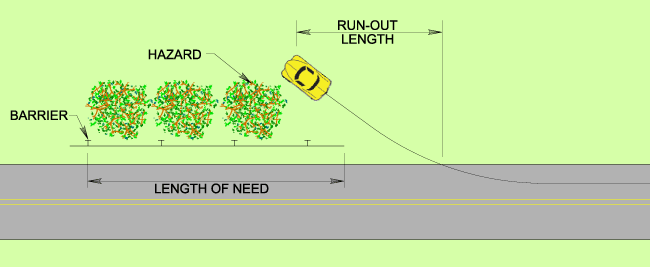Roadside Barrier Layout

An effective guardrail needs to be extended far enough upstream to prevent most errant vehicles from traveling behind the guardrail and striking the roadside hazard. The guardrail should also extend far enough downstream to prevent vehicles from hitting the roadside hazard. If opposing traffic can be expected to crossover and hit the roadside hazard, the downstream end of the guardrail should be extended far enough to shield the roadside hazard from these errant vehicles.
The Figure above shows the variables that should be considered in designing a roadside barrier to shield an obstruction effectively and in determining the length of need, for adjacent traffic. The Lateral Extent of the Area of Concern, and the Runout Length, are the primary factors.
The AASHTO runout length, is the theoretical off-road distance needed for a vehicle that has encroached on the roadside to come to a stop. This distance is measured from the upstream end of the roadside hazard, along the roadway, to the point at which the vehicle is assumed to leave the roadway. The AASHTO manual provides recommended runout lengths, based on the design speed of the roadway and the given traffic volume, to use in determining the barrier length-of-need. Once runout length and lateral extent of the area of concern are known, the AASHTO length of need depends on the tangent length needed upstream of the hazard, its lateral distance from the travel lanes, and the flare rate, designed for the installation.
Many state highway agencies have developed different methods to determine the length-of-need based on their available data. It is suggested to refer to your local state highway agency's design manual to conform to local practice.


